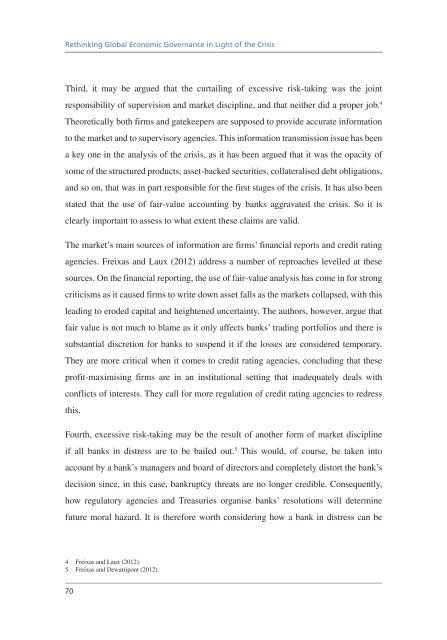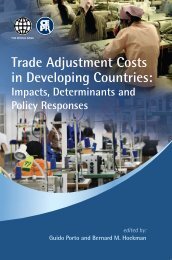Download PDF - Vox
Download PDF - Vox
Download PDF - Vox
- No tags were found...
You also want an ePaper? Increase the reach of your titles
YUMPU automatically turns print PDFs into web optimized ePapers that Google loves.
Rethinking Global Economic Governance in Light of the CrisisThird, it may be argued that the curtailing of excessive risk-taking was the jointresponsibility of supervision and market discipline, and that neither did a proper job. 4Theoretically both firms and gatekeepers are supposed to provide accurate informationto the market and to supervisory agencies. This information transmission issue has beena key one in the analysis of the crisis, as it has been argued that it was the opacity ofsome of the structured products, asset-backed securities, collateralised debt obligations,and so on, that was in part responsible for the first stages of the crisis. It has also beenstated that the use of fair-value accounting by banks aggravated the crisis. So it isclearly important to assess to what extent these claims are valid.The market’s main sources of information are firms’ financial reports and credit ratingagencies. Freixas and Laux (2012) address a number of reproaches levelled at thesesources. On the financial reporting, the use of fair-value analysis has come in for strongcriticisms as it caused firms to write down asset falls as the markets collapsed, with thisleading to eroded capital and heightened uncertainty. The authors, however, argue thatfair value is not much to blame as it only affects banks’ trading portfolios and there issubstantial discretion for banks to suspend it if the losses are considered temporary.They are more critical when it comes to credit rating agencies, concluding that theseprofit-maximising firms are in an institutional setting that inadequately deals withconflicts of interests. They call for more regulation of credit rating agencies to redressthis.Fourth, excessive risk-taking may be the result of another form of market disciplineif all banks in distress are to be bailed out. 5 This would, of course, be taken intoaccount by a bank’s managers and board of directors and completely distort the bank’sdecision since, in this case, bankruptcy threats are no longer credible. Consequently,how regulatory agencies and Treasuries organise banks’ resolutions will determinefuture moral hazard. It is therefore worth considering how a bank in distress can be4 Freixas and Laux (2012).5 Freixas and Dewatripont (2012).70














